6 steps to improve Windows XP speed
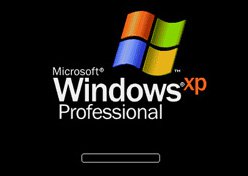 If your computer belongs to the kind of sluggish, heavy, even slightly old-fashioned but you still have no conditions for new shopping, with the simple and quick but very effective settings, the computer will improve Partially improve the speed of the system.
If your computer belongs to the kind of sluggish, heavy, even slightly old-fashioned but you still have no conditions for new shopping, with the simple and quick but very effective settings, the computer will improve Partially improve the speed of the system.
Remove the Indexing Service function for NTFS-formatted hard drives
Indexing Service is a feature that helps NTFS hard disk partitions find and access files faster, but basically this feature can be said to be useless. If you are a regular user of your computer, you can quickly find and access the files on your hard drive. Therefore, shutting down this feature is a simple way to improve the efficiency of the system because Windows keeps 'losing power' when it comes to doing a useless job.
Normally, the default Indexing Service feature is automatically activated by Windows for NTFS hard drive partitions (there is no such feature for FAT format drives), so you can remove the feature. This feature by following these steps:
- First, open the My Computer window. Next, right-click on the formatted partitions in NTFS format (the example here is C drive partition :) and select Properties . (Recently produced high-capacity hard drives are always formatted in NTFS format).
- After selecting Properties for the necessary hard drive partitions, the Properties of the hard drive partition will appear. On the General tab of this window, you will see the Allow Indexing Service option to index the disk for fast file search . Now, click the checkmark option here to remove this Windows feature and click OK .
- A new window asks you to remove the Indexing Service feature for the C drive or all the folders contained within it. Select Apply change to C :, subfolders and files to remove this feature for all folders and files inside the C drive partition and click OK to confirm.
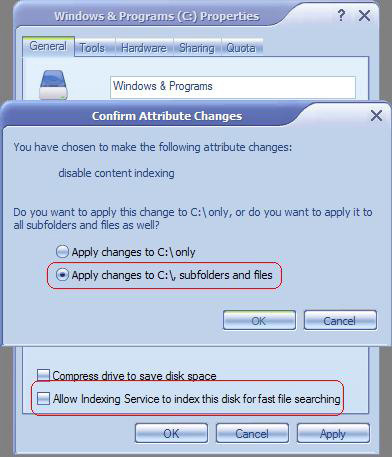
- After you click OK , the process will begin to remove the Indexing Service feature for all files and folders inside the hard drive partition you choose. The process will take long or long depending on the number of files, folders and storage on the selected hard drive partition. If in this process, you receive some Access Denied error messages (Access is denied), you can simply click Ignore All to ignore these errors because these errors can occur when too The process of accessing the operating system files will be denied.
- After the process has finished, you can proceed with the same steps as the remaining NTFS-formatted hard drive partitions.
Otherwise, after removing the Indexing Service feature, you can restore this feature by reversing the steps above.
Conduct defragmenting the drive partitions
Defragmenting a drive is an important job because after many times your computer reads and writes files, small or large, there are many files that are written on non-consecutive parts, creating a lot of free space. Hard drive is called disk fragmentation. That's why when you buy a new computer or a new hard drive, it will work extremely 'smoothly' and smoothly. But over time, after you install, remove, copy, delete files . your computer and your system will become slow and sluggish.
To fix disk fragmentation, Windows provides you with a Defrag utility (called a disk defragmentation utility) that will help to rearrange empty space on your hard drive. This will make the system easier to find and access files than before.
To use the Windows disk defragmentation feature, follow these steps:
- First, right-click My Computer on the desktop, select Manager and select Disk Defragment in the window that appears.
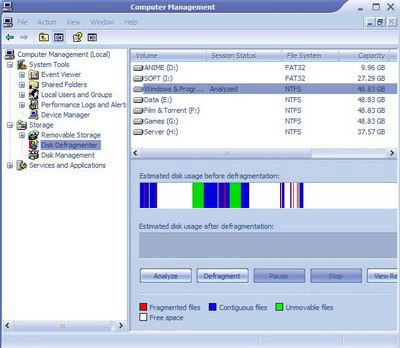
- Disk Defragment window will be displayed. This window contains all the partitions on your hard drive. Before proceeding to defragment the hard drive partitions, select 1 partition of any hard drive on the partition list and click Analyze to check the partition status of the partition. After the checkout process has finished, you will receive a notice that the hard drive partition needs to be defragmented. In case the partition is not fragmented too much, the utility will recommend that you do not need to conduct defragmentation. Conversely, for heavily fragmented partitions, you can click Defragment to defragment the partition.
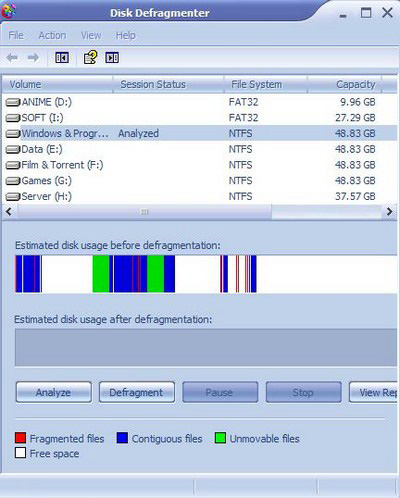
- Time of defragmenting process depends on the level of fragmentation of the selected partition. After the process is finished, you can proceed with the same steps as the remaining partitions.
You should conduct disk defragmentation once a month to ensure that your drive is not fragmented too much, affecting the speed of the system.
Clean up the hard drive
If you own a hard drive with a capacity not too large but contains many different files, such as documents, images, videos, music . will make the hard drive capacity be reduced quickly. Once the hard drive capacity remains small, the files will be stacked on top of each other, the access to the files will be difficult, the system's processes will start to slow down and the end result is speed. The system will be affected. Therefore, cleaning up and deleting unnecessary things on the hard drive will help your system improve speed.
With 5 simple tips that Dan Tri has introduced to you in the article "5 tips to free up hard drive capacity", you can quickly clean up and reorganize your hard drive to be able to both free The storage capacity of the hard drive can both improve the speed of the system.
Remove unnecessary system effects
In Windows XP and later versions, Micorsoft has added many effects to make the interface of the operating system look more beautiful and polished. However, sometimes they cause trouble for the video camera not too high. Removing unnecessary effects is also a simple but effective way to improve the speed of the system. You can follow these steps:
- First, right-click the My Computer icon outside the Desktop and select Properties .
- The System Properties window will be displayed. Here, select the Advanced tab, in the Performance section of this tab, click the Settings button.
- In the new Performance Options window, you will see the Visual Effects tab with the list of operating system effects. Here you can automatically set the system to the Let Windows choose what best for my computer option, this is the system's inherent option. To remove some unnecessary effects and improve the speed of the system, click on the Custom item and click on a few options in the list below. Effects to remove are:
+ Fade hoặc trình bày cửa sổ vào xem
+ Fade or slide tool tips into view
+ Fade out menu items after clicking
+ Show shadows under menus
+ Slide open combo boxes
+ Slide taskbar buttons
+ Smooth-scroll list boxes
+ Use a image background để mỗi kiểu thư mục
+ Use common tasks in folders
- Finally, click OK and restart the computer for the settings to work.
Now try using Windows with new settings and new effects, you'll find that Windows has improved significantly in terms of processing speed.
Set up and use virtual memory
External memory, or RAM, is the memory used to store processes running on the system, so if your system has RAM with a capacity not too large, it will not contain many programs. works at the same time, so your computer will become sluggish and slow, even hang up because the amount of RAM is not enough to distribute all processes.
The easiest way to remedy this situation is to "shop" for your computer with 1 more RAM memory. But there is a simpler way to improve the speed of the system without the cost of setting up virtual memory to use the same RAM as the Virtual Memory feature of Windows XP.
Reduce startup programs with the system
In case your system is already in the slow and heavy category, if you force your system right from the start it has to 'carry' many different utilities at the same time, the boot process will For a long time, it may even take tens of minutes to wait for your system to complete the boot process. Therefore, reducing the startup programs with the system will help your system start smoothly and faster.
In addition, the removal of unnecessary programs during the boot process also makes these unnecessary processes inoperable during the use of a computer, so the system will not need to take over. excess processes and focus system resources on more important processes.
To reduce the programs that start with the system, follow these steps:
- First, click Start , select Run , enter msconfig and press Enter .
- System Configuration Utility window is opened. Here you select the Startup tab.
- At the Startup tab, the list of programs that can start with the system will appear. You can bookmark to select or uncheck a program from this list. You should let computer protection programs such as antivirus, firewall . be started with the system to ensure that the system will be protected from start-up. The remaining programs should be removed from the boot list of the system.
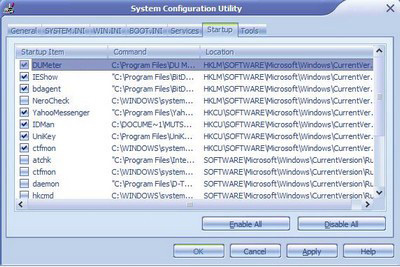
- Finally, click OK and restart the system for the settings to work.
Last words
Only with simple tips, but not all of us can know or pay attention to be able to have the appropriate settings, help the system improve somewhat the speed. Hopefully with these simple tips, your system will improve somewhat before deciding to 'invest' to buy a new computer.
You should read it
- Error missing Disk Cleanup on Windows 10/8/7, this is a fix
- Free up hard drive space automatically on Windows 10 with Disk Cleanup
- Microsoft will delete the Downloads folder in Disk Cleanup on Windows 10 20H1
- Automate maintenance tasks for Windows computers
- Turn screensavers into hard disk defragmentation
- 10 ways to open Disk Defragmenter on Windows
- Download Smart Defrag Pro 5, the $ 9.99 price defragmentation app, which is free
- Steps to fix Indexing is Paused error in Windows 11
May be interested
- 12 tips to speed up your computer comprehensively
 there are many reasons for slow computer performance, which may be due to software or hardware failure. and after a long time using the computer, downloading the programs to the computer and installing, and you realize that your computer is getting slower and slower, the boot process lasts for an hour to start up. , processing applications, manipulation takes a lot of time.
there are many reasons for slow computer performance, which may be due to software or hardware failure. and after a long time using the computer, downloading the programs to the computer and installing, and you realize that your computer is getting slower and slower, the boot process lasts for an hour to start up. , processing applications, manipulation takes a lot of time. - 2 tools to improve typing speed for programmers
 tools for practicing typing skills often focus more on the alphanumeric keys, but a programmer-only tool focuses on the symbol keys primarily.
tools for practicing typing skills often focus more on the alphanumeric keys, but a programmer-only tool focuses on the symbol keys primarily. - Instructions to improve the speed of old computers simply
 windows computers are always slowing down over time, which is a fact that people have seen for a long time. however, most of the slow causes do not come from hardware. hardware power is still almost the same. startup software, junk files, or even agents like dirt, can slow down your computer.
windows computers are always slowing down over time, which is a fact that people have seen for a long time. however, most of the slow causes do not come from hardware. hardware power is still almost the same. startup software, junk files, or even agents like dirt, can slow down your computer. - Maximize your Mac
 mac computers can serve for years without problems, but you need to know how to keep your computer working. the following are measures to improve machine speed, both in hardware and software.
mac computers can serve for years without problems, but you need to know how to keep your computer working. the following are measures to improve machine speed, both in hardware and software. - Tips to speed up your browser on Windows 10
 you can still do the following to make the web experience much faster and smoother. tipsmake.com will guide ways to set up windows to improve your browsing speed.
you can still do the following to make the web experience much faster and smoother. tipsmake.com will guide ways to set up windows to improve your browsing speed. - Trick to improve browsing speed with Chrome browser
 chrome is one of the best browsers out there, which is no longer controversial. however, like some other browsers, suddenly on a beautiful day when you are surfing the web on chrome, the browsing speed is slow, and even hangs ...
chrome is one of the best browsers out there, which is no longer controversial. however, like some other browsers, suddenly on a beautiful day when you are surfing the web on chrome, the browsing speed is slow, and even hangs ... - What is HTTP3?
 it will be very quick, site owners will have the option to use the new http / 3 to improve website speed and when the browser adopts the new protocol, you will see faster data download speed.
it will be very quick, site owners will have the option to use the new http / 3 to improve website speed and when the browser adopts the new protocol, you will see faster data download speed. - Trick to speed up Android phones after a period of use
 after a long time of use, your android device will gradually decrease in quality of operation. sometimes a slow, slow state occurs when performing operations or accessing applications.
after a long time of use, your android device will gradually decrease in quality of operation. sometimes a slow, slow state occurs when performing operations or accessing applications. - Tips to speed up the gaming machine
 computers when purchased are usually smooth, applications work well. but after a period of use, users will notice the speed of the machine is reduced relatively: sluggish machine when running the game, not guaranteed frame rate. hardware upgrades are not always the best solution.
computers when purchased are usually smooth, applications work well. but after a period of use, users will notice the speed of the machine is reduced relatively: sluggish machine when running the game, not guaranteed frame rate. hardware upgrades are not always the best solution. - Which upgrade will improve your computer's performance the most?
 do you feel your pc is running slowly? it's time to consider upgrading some of your hardware components.
do you feel your pc is running slowly? it's time to consider upgrading some of your hardware components.










 Connect your Windows XP computer from Windows Vista
Connect your Windows XP computer from Windows Vista 'Clear the way' for Win XP to boot faster (Part 1)
'Clear the way' for Win XP to boot faster (Part 1) 'Clear the road' for faster Windows XP booting (Part 2)
'Clear the road' for faster Windows XP booting (Part 2) Set the auto-login mode to Windows XP
Set the auto-login mode to Windows XP Turn the word Start on Windows XP into a custom name
Turn the word Start on Windows XP into a custom name Exploiting services in Windows 2000, XP, 2003 improves productivity
Exploiting services in Windows 2000, XP, 2003 improves productivity